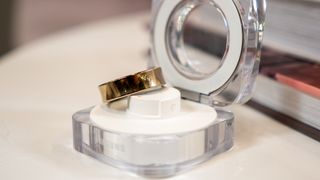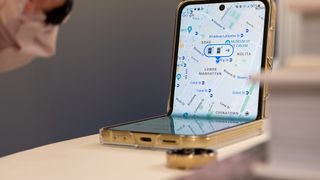Samsung Galaxy Ring hands-on: Oura should be worried
The Galaxy Ring looks great, feels nice, and has some interesting features.

After months of teasers, Samsung's Galaxy Ring is finally here. The latest entrant in the growing smart ring category comes from one of the best smartphone and smartwatch manufacturers, and Oura, the company that essentially kickstarted the category, doesn't appear to be worried. But should it be?
The Galaxy Ring seems to have quite a lot going for it and all the R&D dollars that Samsung is willing to throw at it. The result is a surprisingly polished smart ring with all the health features one would expect and some unique features we didn't think we'd see. As someone who is a big fan of smart rings, having reviewed a few myself, my brief hands-on with the Galaxy Ring makes me pretty excited about the future of these wearables.
| Category | Galaxy Ring |
|---|---|
| Dimensions | 7.0mm (width) x 2.6mm (depth) |
| Weight | 2.3-3g |
| Materials | Titanium grade frame |
| Water resistance | 10ATM, IP68 |
| Colors | Titanium Black, Titanium Gold, Titanium Silver |
| Sizes | 5–13 |
| Connectivity | Bluetooth LE 5.4 |
| Sensors | Accelerometer, PPG, skin temperature |
| Battery | 18mAh-23.5mAh, 40% in 30 minutes |
| Charging cradle | 361mAh |
Samsung Galaxy Ring: My own, my love, my... precious

What surprised me most about the Galaxy Ring is how thin and light it is. The ring weighs as little as 2.3g or as much as 3g, depending on the size you get, and it's actually quite impressive. Given how there's so much tech packed into this, the ring is also surprisingly thin, or at least it appears so. At 2.6mm, it's slightly thicker than the Oura Ring, but the concave design itself gives the appearance that it's much thinner.
The result is a ring that feels more like a ring and less like a regular smart ring, which I feel is the ultimate goal of wearable tech: to naturally blend in with your lifestyle. Even the design is more subtle than I expected, and the titanium build feels quite durable. I'll have to spend more time with it to see how well it fares in daily use, as my Oura Ring has accumulated a number of scuffs and scratches.

I'm a bit bummed that Samsung isn't offering covers for the ring, which is something I wish more smart ring makers would do since I like to wear them while I work out. Hopefully, down the line, Samsung can make them available so users can protect their rings when they expect to do more strenuous activities.
What is nice is that, unlike most smart ring makers, Samsung provides a charging cradle for the Galaxy Ring. It's a lot smaller than the cradle for the RingConn Smart Ring, although it has less battery capacity, too. Still, given the 7-day battery life of the Galaxy Ring, I think it's a good trade-off, as it makes it much easier to carry around, and it's not like the ring will need to be charged very often.

In contrast with the rather subtle-looking ring, the included charging cradle is quite flashy with its transparent design. The cradle provides a nice lighting effect when the ring is placed to indicate the charging status, which is a nice feature.
Be an expert in 5 minutes
Get the latest news from Android Central, your trusted companion in the world of Android
Samsung is offering the ring in nine sizes, from size 5 to 13, so there should be options for most people, and it is recommended to use it on your pointer finger.
Samsung Galaxy Ring: Going above and beyond

Wellness is the name of the game, and the ring is able to do things like monitor your heart rate, track your sleep, detect workouts like walking and running, and even help predict menstrual cycles. It'll all be handled with Samsung Health, and Samsung is leveraging Galaxy AI to help provide insights like a sleep score, and all your vitals and activities will contribute to an energy score that will help you take charge of your day. If this sounds familiar, it's because this is what other smart rings do, so there aren't really any novel features on the health and wellness side.
However, Samsung is taking things a little further with the Galaxy Ring's capabilities, letting it do things you won't find on many other devices. The first of which is gestures, a feature that was hinted at in previous patents and which we frankly didn't expect to see on the finished product. When trying out the Galaxy Ring, I was able to snap some photos using the Galaxy Z Flip 6 just by pinching my fingers together twice. The same gesture also dismisses alarms, which is particularly helpful for people who prefer to sleep with smart rings over smartwatches.
The gestures worked surprisingly well when I tried them, and it makes me wonder what else Samsung has planned for the Galaxy Ring.

Samsung also demonstrated the ability to locate the Galaxy Ring based on its current or last-known location. The Galaxy Ring supports Bluetooth LE 5.4, and Samsung Find is able to ping the ring by turning on its sensor lights to help you locate it if it's nearby. I'm not sure how helpful this will be in actual use, as the lights weren't very noticeable in the bright environment I was in, but given the lack of finding features on other smart rings (I'm looking at you, Oura), I can't fault Samsung for doing what it can, and every bit helps.
Samsung Galaxy Ring: High upfront cost, low ownership cost

The Galaxy Ring costs a lofty $399, which is no small price for such a small device. The That's easily $100 more than competing smart rings, including the cheapest Oura Ring styles and much more than the starting price for the Galaxy Watch 7. I'm not really sure what mind Samsung was in to charge this much for the smart ring, but I suppose they have to cover R&D costs somehow.
The saving grace is that, unlike Oura, the Galaxy Ring won't require a subscription. Oura charges $5.99 per month to access its most useful, which equals about $72 a year. So, in the long run, the Galaxy Ring is cheaper than the Oura Ring. But still, that's a pretty steep upfront cost given that plenty of other (cheaper) smart rings don't require a subscription either, and I imagine it might deter some users on a product category that is still taking off with one proven contender and a handful of smaller companies.

In addition, Samsung may be playing the long game with the Galaxy Ring, similar to Oura. In a recent interview, Oura suggested that we shouldn't expect a Gen 4 any time soon as the company continues stuffing new features and capabilities into the ring. I can see Samsung going this route, keeping the same model Galaxy Ring for several years before possibly offering an upgraded model. This way, the upfront cost won't hit as hard since you won't have to worry about a newer, better model arriving the following year.
Preorders for the Galaxy Ring start on July 10, and it goes on sale on July 24.

Derrek is the managing editor of Android Central, helping to guide the site's editorial content and direction to reach and resonate with readers, old and new, who are just as passionate about tech as we are. He's been obsessed with mobile technology since he was 12, when he discovered the Nokia N90, and his love of flip phones and new form factors continues to this day. As a fitness enthusiast, he has always been curious about the intersection of tech and fitness. When he's not working, he's probably working out.
-
Averix I would much rather pay a slightly higher up front cost and not have to shell out a monthly fee to use something I bought. I'm sick of these subscription hardware devices.Reply